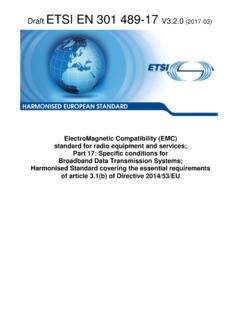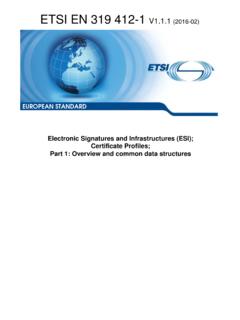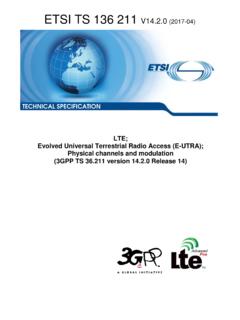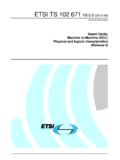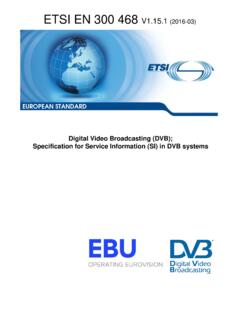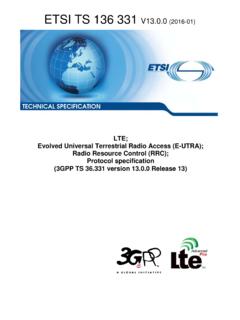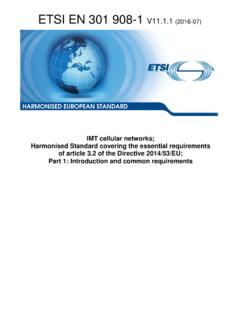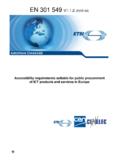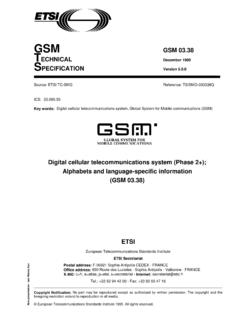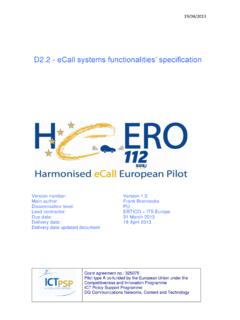Transcription of GANA - Generic Autonomic Networking …
1 etsi white paper No. 16 GANA - Generic Autonomic Networking Architecture Reference Model for Autonomic Networking , Cognitive Networking and Self-Management of Networks and Services First edition October 2016 ISBN No. 979-10-92620-10-8 Authors: Tayeb Ben Meriem, Ranganai Chaparadza, Beno t Radier, Said Soulhi, Jos -Antonio Lozano-L pez, Arun Prakash ETSI 06921 Sophia Antipolis CEDEX, France Tel +33 4 92 94 42 00 GANA Generic Autonomic Networking Architecture 2 About the authors Tayeb Ben Meriem Co-editor & Contributor, Orange, Chair ETSI NTECH AFI Working Group Ranganai Chaparadza ; Co-editor & Contributor, Vodafone/consultant Beno t Radier Contributor, Orange Said Soulhi Contributor, Verizon Jos -Antonio Lozano-L pez Contributor, Telefonica TID Arun Prakash Contributor, Fraunhofer Fokus This white paper was compiled on the basis of the ETSI GS AFI 002 Specification on the GANA Reference Model and other inputs the authors and editors of the white paper took into consideration and are cited in the paper .
2 Acknowledgements go to the whole list of contributors to the ETSI GS AFI 002 specification listed at the end of the ETSI GS AFI 002 [3]. GANA Generic Autonomic Networking Architecture 3 Contents About the authors 2 Contents 3 Executive Summary 4 Introduction 5 The Emerging AMC Paradigm 7 Definition of the AMC paradigm 7 The GANA Reference Model 10 Design principles of the GANA Reference Model 10 GANA Core Concepts 12 Example Use Cases of GANA in a Target Network Architecture 18 To whom is the GANA Model Addressed? 22 Interoperability of Autonomics Software Components, and Compatibility of the Hybrid-SON Model with the GANA Model 25 Implementation Guide for GANA 27 Example Instantiation Case for GANA: GANA Instantiation onto the Backhaul and Core network (EPC) parts of the 3 GPP Architecture 32 GANA in the Unified Architecture for AMC, SDN, NFV, E2E Orchestration & Specialized Big Data Analytics 35 Harmonization of Standards & Architectures for Emerging Networking Paradigms 35 Proposed Unified Architecture for AMC, SDN, NFV, E2E Orchestration, and specialized Big Data Analytics 35 Call for GANA Proofs of Concept 39 How to contribute to the Standards for AMC 39 References 40 GANA Generic Autonomic Networking Architecture 4 Executive Summary The industry consensus is that in the digital services ecosystem, networks evolve to so-called smart networks of the future , which are characterized by the need to be operated based on principles of dynamically adaptive Automated and Autonomic Management & Control (AMC)
3 Of networks and services (aka autonomics). AMC replaces the increasingly complex and error-prone manual and static management and optimization of networks and services. Telecom operators, service providers, cloud services providers, equipment Providers, Network Functions Virtualization (NFV) product providers, Software Defined Networking (SDN) product providers, Operations and Support Systems (OSS) vendors, ISVs (Independent Software Vendors), application developers, regulators and other significant players in these Digital Services ecosystems now want to clearly understand the achievement and progress in standardization work on AMC as well as the impact of AMC on the roadmap for network and services management evolution, including the roadmap on autonomics standards. This clarity will help them in their decisions to invest time and financial resources in standardization of autonomics and deployment of standards-based self-management related solutions for networks and services.
4 It will also help them understand how to apply AMC to concrete use cases, and how AMC relates to other technologies such as Self Organizing Networks (SON), SDN, and NFV. The AFI working group in ETSI s NTECH Technical Committee, as the leading group in the standardization landscape for AMC, has a comprehensive work programme which comprises deliverables on: a reference model for a Generic Autonomic Network Architecture (GANA); an implementation guide for the GANA reference model; and autonomics-enabled implementation-oriented architectures that are a result of GANA instantiations onto various reference architectures defined by standardization organizations such as 3 GPP, BBF, IEEE, ITU-T and other Standards Developing Organizations (SDOs). The GANA model defines a Generic AMC framework and structure within which to specify and design autonomics-enabling functional blocks (GANA functional blocks) for any network architecture and its management architecture a process called GANA instantiation onto target architecture.
5 An example of a use case for autonomics technology that is now being deployed is SON Functions for Radio Access Networks (RANs). As readers study the GANA model, they realize that it shares common principles with the Hybrid SON architectural model, as they both enable combining and interworking centralized and distributed management and control solutions for networks and services. As such, the SON (now being deployed) is compatible with the GANA model design principle. GANA Functional Blocks (FBs) instantiated in network segments outside of RAN ( backhaul and core network segments) can complement SON functions in the RAN. The principles defined by the GANA model are expected to play a role in addressing the emerging requirements for autonomics that go beyond those addressed by the current SON, such as the 5G-SON requirements as well as other autonomics-related requirements that constitute operations efficiency requirements, as defined in the NGMN 5G white paper [17].
6 Also, industry and the R&D community at large are interested in understanding how the GANA model, as a reference model for the AMC paradigm, articulates with reference models for the other emerging complementary Networking paradigms of NFV, SDN, and end to end (E2E) orchestration of resources and services all of which are viewed together with AMC as complementary software-oriented enablers for 5G. ETSI NTECH AFI is addressing this topic together with other SDOs/Fora involved in the recently launched initiative called Joint SDOs/Fora Industry Harmonization on Unified Standards for AMC, SDN, NFV, & E2E Service Orchestration [13]. GANA Generic Autonomic Networking Architecture 5 Introduction Autonomic networks enable product innovation, network services innovation, operational efficiency for networks and services and smart and intelligent networks that exhibit self-* features such as self-configuration, self-repair/healing, self-protection, self-optimization and self-awareness.
7 The industry consensus is that as networks evolve to future networks, networks and services need to be operated based on principles for dynamically adaptive automated and Autonomic management & control of networks and services. A recent industry workshop organized by IWPC, dubbed Forging a Path to Autonomous 5G Networks [29], is another example of the growing calls for evolution of management and control of networks and services through autonomics. GANA and efforts in ETSI NTECH AFI on standards for autonomics were presented at this IWPC workshop. Therefore, standardization of the technology of Autonomic Management & Control (AMC), that reflects dynamically adaptive automated and Autonomic management & control of networks and services, has to address the following key requirements: Need for Generic reference model that enables developers of Autonomic Functions (AFs) to identify the abstractions at which Autonomic functions (referred to as Decision-making-Elements (DEs)) can be designed and interworked within node architectures and the overall network architectures; Need for instantiation cases of the Generic model onto implementation-oriented reference architectures (existing or future architectures); Need for an implementation guide for the reference model and associated instantiation cases.
8 Need to build trust & confidence in autonomics by addressing stability of control loops and quality & correctness of the decision-making element algorithms and logic of the embedded Autonomic functions; Need for Proofs of Concept (PoCs) of AMC based on the standardized reference model; Need for interworking & harmonization of Autonomic management & control and other complementary paradigms, SDN, NFV, E2E Service Orchestration, to move from silos towards harmonized and combined paradigms within a unifying architecture. There is thus an onus on the autonomics standardization community to provide the answers to those requirements, and this is in fact the principal purpose of the creation of the ETSI NTECH AFI group in 2009. ETSI NTECH AFI Working Group (WG), as the leading SDO in the standardization landscape for AMC, has a comprehensive work programme which comprises deliverables on: a reference model for a Generic Autonomic Network Architecture (GANA) [3]; an implementation guide for the GANA reference model [10]; autonomics-enabled implementation-oriented architectures that are a result of GANA instantiations onto various reference architectures defined by standardization organizations such as: 3 GPP, Broadband Forum (BBF), IEEE, ITU-T, and other SDOs [13], [14]; a specification of the Proof-of-Concept (PoC) Framework aimed at encouraging the industry to set up demonstrations of Autonomic management capabilities in services and networks [16].
9 GANA Generic Autonomic Networking Architecture 6 Therefore, this white paper primarily covers the following topics and objectives: Understanding the core concepts of the GANA reference model as the first standard that translates the industry requirements in terms of need for dynamic/adaptive Autonomic management & control of networks and services and the need to define the abstraction levels at which closed control-loops can be designed and interworked in a hierarchical and nested fashion; Answers to the question: to whom is the GANA Model addressed? Understanding how to apply the GANA reference model to well-known architectures (3 GPP, BBF, etc.) using the GANA Implementation Guide; Insights on the relationship between GANA and SON; Insights on how to integrate/interwork the GANA model and complementary paradigms such as SDN, NFV, E2E orchestration of resources and services, Big Data analytics applications for AMC; Insights on how the GANA model should play a vital role in the white box Networking paradigm GANA Generic Autonomic Networking Architecture 7 The Emerging AMC Paradigm Definition of the AMC paradigm Autonomic Management & Control (AMC) AMC is about Decision-making-Elements (DEs) as Autonomic functions ( control-loops) with cognition introduced in the management plane as well as in the control plane (whether these planes are distributed or centralized).
10 Cognition (learning and reasoning used to effect advanced adaptation) in DEs, enhances DE logic and enables DEs to manage and handle even the unforeseen situations and events detected in the environment around the DE(s). Control is about control-logic as the kernel of the DE that realizes a control-loop in order to dynamically adapt network resources and parameters or services in response to changes in network goals/policies, context changes and challenges in the network environment that affect service availability, reliability and quality. Such control-logic is called a Decision-making Element (DE) in GANA terminology. DEs realize self-* features (self-configuration, self-optimization, etc.) as a result of the decision-making behaviour of a DE that performs dynamic/adaptive management and control of its associated Managed Entities (MEs) and their configurable and controllable parameters.
